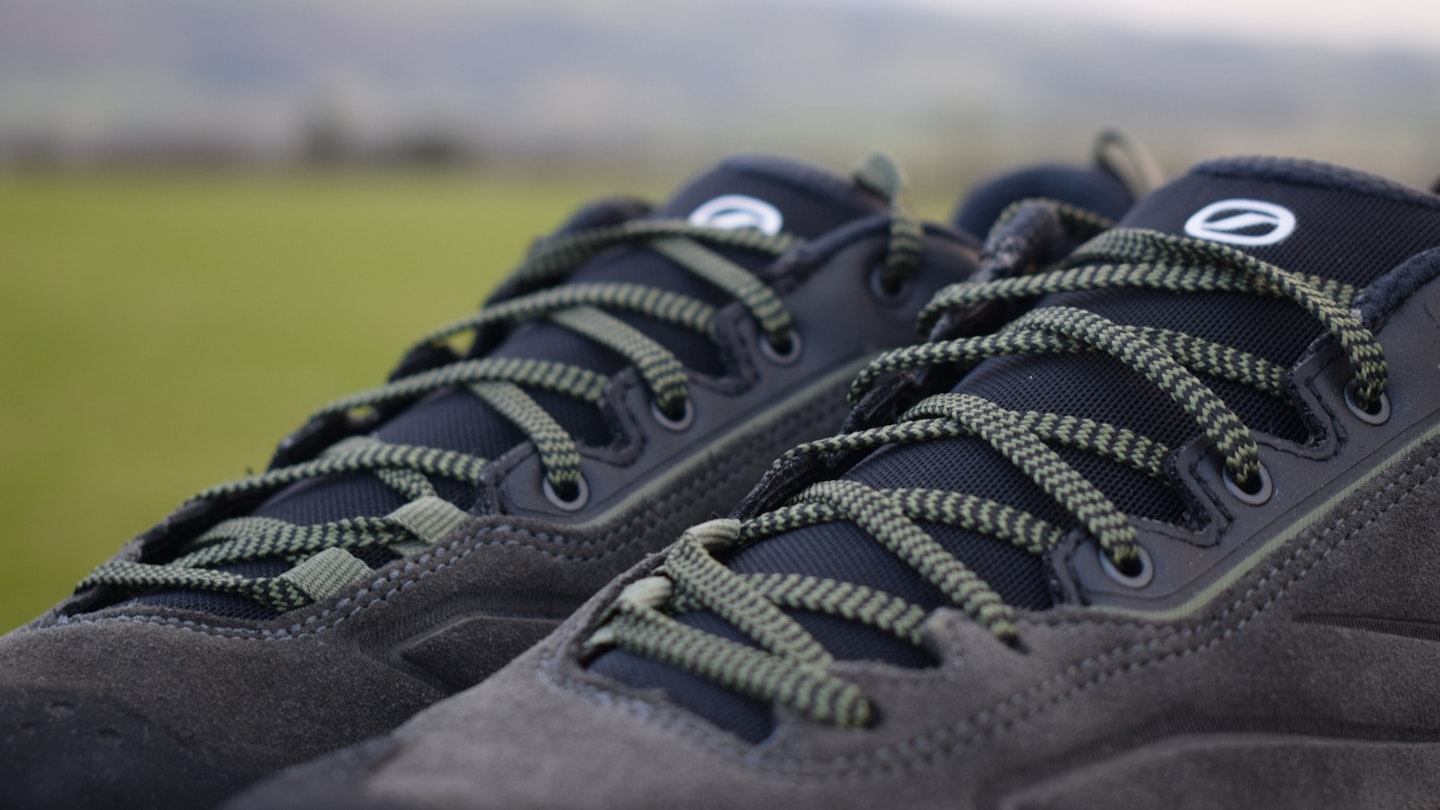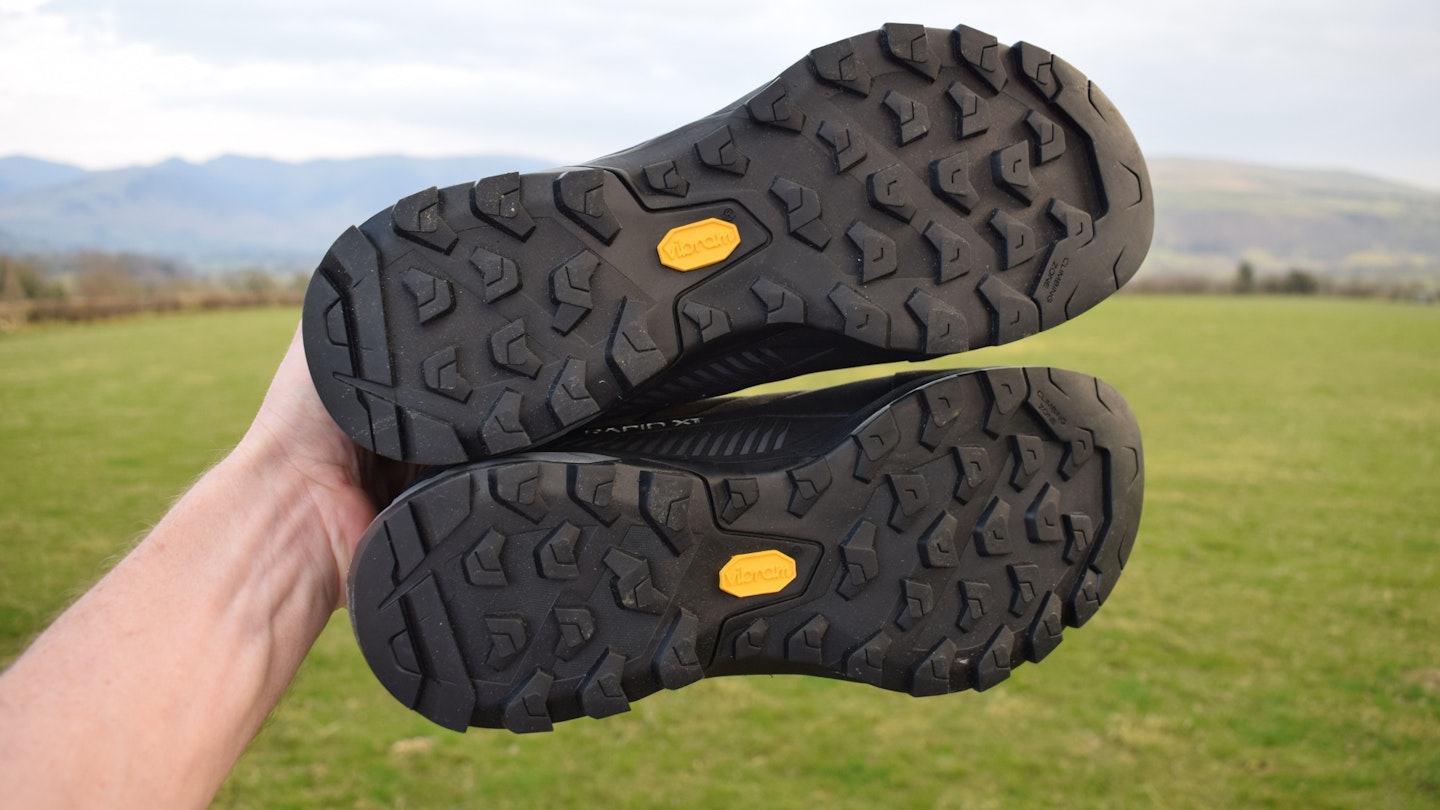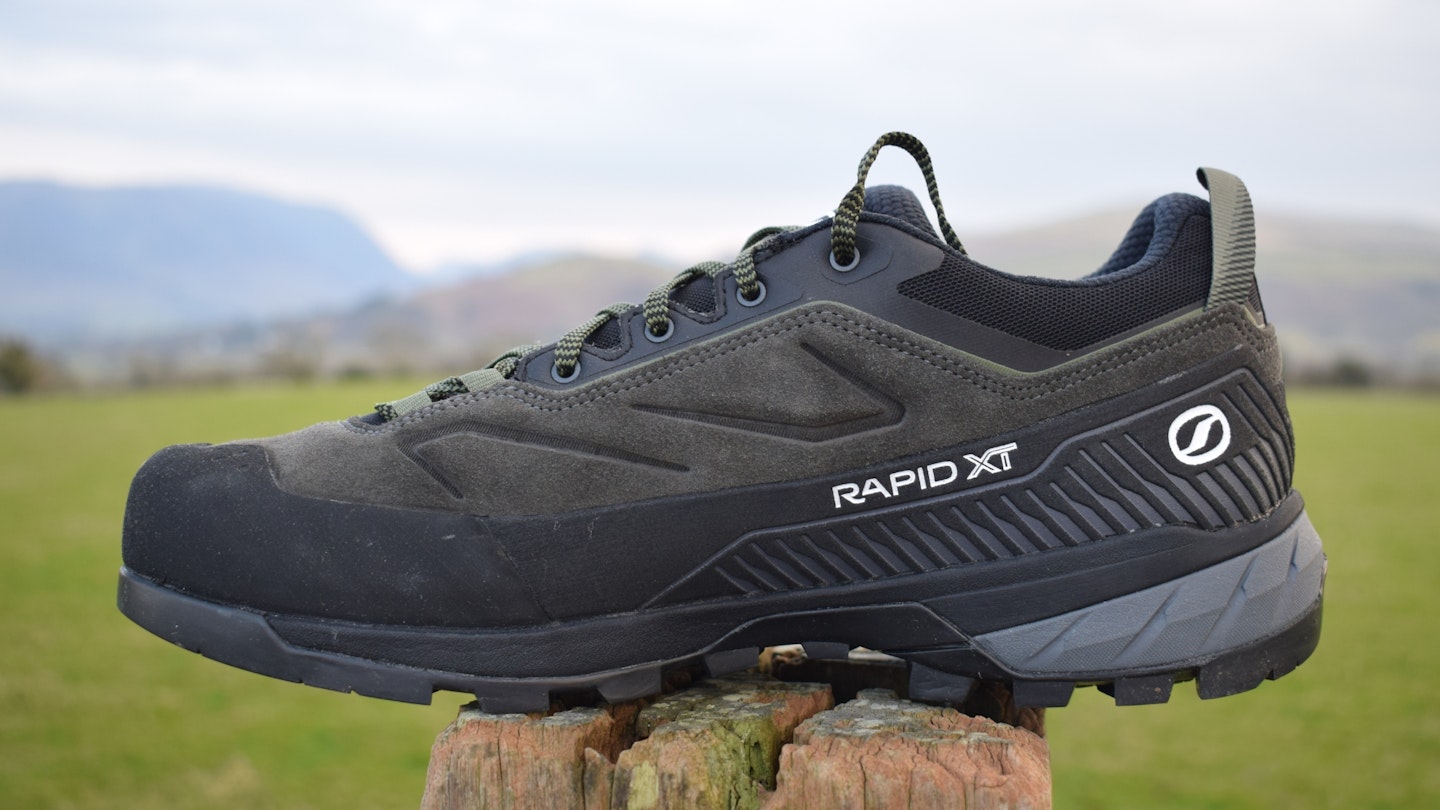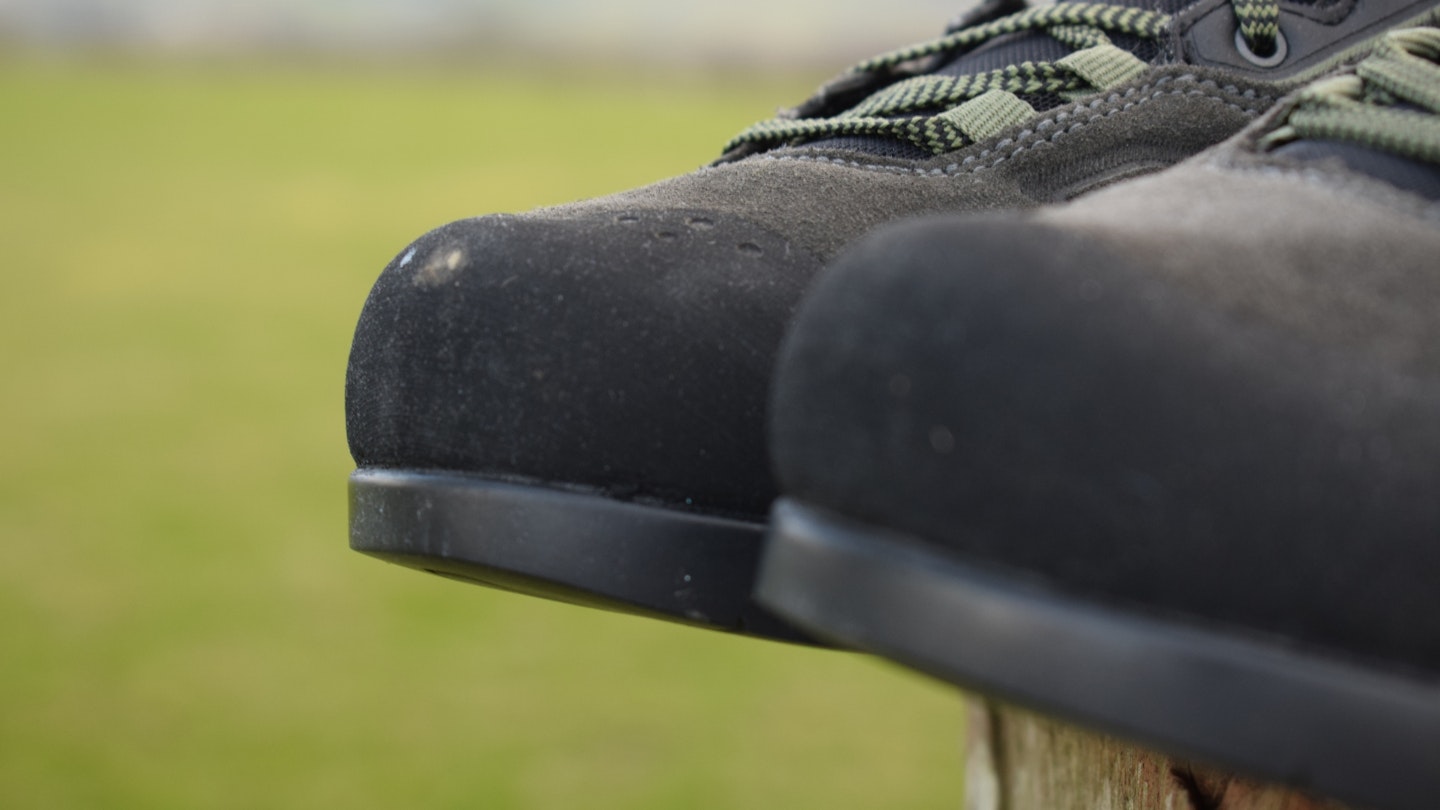The Rapid XT GTX is part of Scarpa’s ‘Fast & Light’ family of approach shoes, footwear designed for speed and performance when scrambling or taking on low-grade multi-pitch climbing routes.
Scarpa is keen to stress their versatility, championing them as the “meeting point between hiking, running and climbing taking the best from each category”. Pitting them against our exacting trails and comparing them with some other impressive hiking shoes, it didn’t take long to appreciate what Scarpa is driving at here.
The Rapid XT GTX is the waterproof version of the shoe and features a protective wrap-around TPU rand, reinforcements at the toe and a Vibram MegaGrip outsole with flat climbing zones at the front and back – all the hallmarks of a capable and protective approach shoe.
The upper is made from suede, which is nice and soft, though less durable than the hardier nubuck leathers seen in some hiking shoes. It’s relatively light for an approach shoe and super grippy, while its rand and reinforcements provide a great shield against rock abrasion.
It’ll please keen scramblers and summer peak baggers, though the low cut isn’t ideal in boggy terrain. Nevertheless, if you can live with the hefty price, you’ve got yourself a very capable mountain shoe.
Find the women's version here.
Pros
- Relatively light for an approach shoe
- Good levels of protection
- Ironclad grip on rock
Cons
- Not as rugged as some
- Low cut can let water in
- Rather pricey
| RRP: | £185 / $169 |
| Men’s sizes: | UK 6.5-13 |
| Women’s sizes: | UK 4-8 |
| Weight: | 406g / 14.3oz per shoe (men’s UK 8) |
Upper and waterproofing
The upper is made from 1.8mm-thick suede, which gives it a velvety texture and a classic aesthetic. Suede is taken from the softer, lower levels of animal hide compared to something like nubuck, which comes from the harder-wearing layers towards the surface.
While suede is naturally a tough material, it’s not as durable as the nubuck seen in the likes of La Sportiva’s TX5 Low or Salomon’s X-Ultra Alpine. However, suede has the advantage of pliability – it’s a material that moves more easily with the foot. So, the Rapid XT feels less rigid than some.
Suede provides a certain amount of protection against rock abrasion but, to achieve a truly effective shield, Scarpa have employed a wrap-around TPU rand, as well as noticeably thicker and firmer reinforcements at the toes. This enabled me to wedge and jam my way up rock steps without hesitation, safe in the knowledge that my footwear was up to the task.

The GTX version of the Rapid XT has a Gore-Tex bootie for repelling liquid. In this case, it’s Gore-Tex’s eco-friendly ePE liner (the “most breathable” version), a membrane that’s bluesign approved – a certification that indicates responsible textile manufacture.
This internal layer allows moisture to escape while stopping water from getting in. However, as is always the case with low-cut hiking footwear, there’s always the danger of water ingress over the top on boggy terrain or when you inadvertently dunk your foot during a tricky river crossing.
The unfussy lacing system brings everything together, with the top eyelets being a little closer towards the toes than on standard hikers. This leads to a tighter fit towards the front of the foot – a desirable quality that enables greater precision when it comes to footwork.
Midsole

The Agility XT midsole is designed to provide stability, localised cushioning and comfort on rough terrain. The EVA insole, provided by Ortholite, boasts subtly different densities, helping to cushion impacts in key regions of the foot.
The midsole also plays host to a TPU insert. This enhances the rigidity of the shoe, in essence strengthening its structure and providing increased stability on scrambling terrain.
I found it was nicely supportive during my days on the trails. Indeed, Scarpa names the ridges of Snowdonia and the rocky trails of the Lake District as specific use cases.
Outsole
The design of the outsole points towards a truly versatile piece of footwear that should be capable on all manner of terrain. It’s obviously more orientated towards trails and mud than Scarpa’s Crux approach shoes, which are aimed more towards climbers.
The deep, angular lugs through the sole’s centre aren’t too far removed from those seen in mud gripping trail running shoes, such as those seen in Salomon’s Speedcross range.

However, the Rapid XT is also a capable scrambler thanks to its semi-rigid construction and flatter ‘climbing zones’ in the sole. A more rigid sole holds the foot in place comfortably when stepping on small rocky edges, providing much more confidence than standard hiking or running footwear when scrambling.
Meanwhile, the climbing zones provide a flat region of climbing shoe style sticky rubber for techniques like edging and smearing.
The rubber used to achieve the grip is Vibram’s MegaGrip, very much a mainstay when it comes to premium approach shoes. This sticky yet durable compound provides exceptional traction on rock, even when wet.
Price and performance
Direct from Scarpa, the Rapid XT GTX is currently priced at £185, but you can usually find it a little bit cheaper from other outlets.
You could always forego the Gore-Tex and opt for the less expensive Rapid XT(£165/$169), or there’s also the pricier option of the Rapid XT Mid GTX boot (£195/$199), which features a higher cut around the ankle and is better suited to longer days on the trail with a heavier pack.

The Rapid XT GTX feels less robust and slightly less protective than the heavier La Sportiva Low TX5 GTX, a shoe slanted slightly more towards hiking. As mentioned, Scarpa has prioritised minimalism and low weight here so the Rapid XT is bound to feel a little bit less protective, weighing around 100g less per pair.
Its suede is more pliable than the TX5’s nubuck. If speedy missions are your thing, the Scarpa shoe is the better option. For durability, the TX5 has the edge.
Comfort is a multi-faceted thing. The relatively low weight of the Rapid XTs meant that my feet felt less fatigued after a long day on the trail than less minimalist options, particularly when moving fast.
On the other hand, these aren’t the most cuddly pair of shoes I’ve ever worn. Fairly thin cushioning, a rigid sole and robust rand all give them a bit of a harsh feel. I guess Scarpa would say something along the lines of: “What do you expect mate? These are for scaling the Dolomites, not for popping to Cafe Nero.”

It’s in the mountains that the Rapid XTs really excel and I found their performance was strong throughout. Agile, grippy and breathable, they’re a pleasure to wear on the trails.
When it came to getting intimate with rock steps and more sustained scrambling, the Vibram sole really came into its own. It sticks superbly to slabby rock and provides confidence even when the terrain is damp.
The caveat here is that wet, slippery rock is still wet, slippery rock no matter what’s on your feet. That said, I’d rather be wearing these than 95% of the other options on the market when it comes to romping up a rake in the rain.
I found their performance suffered when dirty, as grime creates a lubricating layer between the rock and the sticky rubber, so it's worth giving them a quick brush off before taking on any really technical sections. But then, this is true of all footwear.
The toe region isn’t as aggressively pointed as with some approach shoes, though the precision offered is more than enough for scrambling grades and easy climbing routes. Speaking of the toe region, it’s also fairly wide, offering a decent amount of wriggle room.
Verdict
My overall verdict? This minimalist yet protective shoe will appeal to those who like fast and light missions in the mountains but also value the security of an approach shoe for technical scrambling.
It doesn’t offer the support needed for trekking with a heavier pack and there are more durable approach shoes out there too. However, this well-designed, lightweight rock-hopper is very capable indeed, if you can stomach the price.
Shop this product
About the author

James Forrest writes regular features and route guides for Trail and LFTO, and has been one of our main gear testers for the last few years. James is based on the edge of the Lake District so when he isn’t off on his latest crazy adventure or challenge, he’s walking in his local fells.



